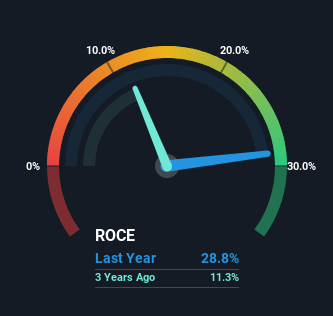- Mexico
- /
- Infrastructure
- /
- BMV:GAP B
Grupo Aeroportuario del Pacífico. de (BMV:GAPB) Is Very Good At Capital Allocation

There are a few key trends to look for if we want to identify the next multi-bagger. One common approach is to try and find a company with returns on capital employed (ROCE) that are increasing, in conjunction with a growing amount of capital employed. This shows us that it's a compounding machine, able to continually reinvest its earnings back into the business and generate higher returns. With that in mind, the ROCE of Grupo Aeroportuario del Pacífico. de (BMV:GAPB) looks great, so lets see what the trend can tell us.
What Is Return On Capital Employed (ROCE)?
If you haven't worked with ROCE before, it measures the 'return' (pre-tax profit) a company generates from capital employed in its business. To calculate this metric for Grupo Aeroportuario del Pacífico. de, this is the formula:
Return on Capital Employed = Earnings Before Interest and Tax (EBIT) ÷ (Total Assets - Current Liabilities)
0.29 = Mex$15b ÷ (Mex$73b - Mex$23b) (Based on the trailing twelve months to June 2024).
Therefore, Grupo Aeroportuario del Pacífico. de has an ROCE of 29%. In absolute terms that's a very respectable return and compared to the Infrastructure industry average of 24% it's pretty much on par.
Check out our latest analysis for Grupo Aeroportuario del Pacífico. de

Above you can see how the current ROCE for Grupo Aeroportuario del Pacífico. de compares to its prior returns on capital, but there's only so much you can tell from the past. If you'd like, you can check out the forecasts from the analysts covering Grupo Aeroportuario del Pacífico. de for free.
What Does the ROCE Trend For Grupo Aeroportuario del Pacífico. de Tell Us?
We like the trends that we're seeing from Grupo Aeroportuario del Pacífico. de. Over the last five years, returns on capital employed have risen substantially to 29%. The company is effectively making more money per dollar of capital used, and it's worth noting that the amount of capital has increased too, by 46%. This can indicate that there's plenty of opportunities to invest capital internally and at ever higher rates, a combination that's common among multi-baggers.
For the record though, there was a noticeable increase in the company's current liabilities over the period, so we would attribute some of the ROCE growth to that. Essentially the business now has suppliers or short-term creditors funding about 31% of its operations, which isn't ideal. It's worth keeping an eye on this because as the percentage of current liabilities to total assets increases, some aspects of risk also increase.
The Key Takeaway
To sum it up, Grupo Aeroportuario del Pacífico. de has proven it can reinvest in the business and generate higher returns on that capital employed, which is terrific. And a remarkable 107% total return over the last five years tells us that investors are expecting more good things to come in the future. So given the stock has proven it has promising trends, it's worth researching the company further to see if these trends are likely to persist.
If you want to continue researching Grupo Aeroportuario del Pacífico. de, you might be interested to know about the 2 warning signs that our analysis has discovered.
If you'd like to see other companies earning high returns, check out our free list of companies earning high returns with solid balance sheets here.
New: Manage All Your Stock Portfolios in One Place
We've created the ultimate portfolio companion for stock investors, and it's free.
• Connect an unlimited number of Portfolios and see your total in one currency
• Be alerted to new Warning Signs or Risks via email or mobile
• Track the Fair Value of your stocks
Have feedback on this article? Concerned about the content? Get in touch with us directly. Alternatively, email editorial-team (at) simplywallst.com.
This article by Simply Wall St is general in nature. We provide commentary based on historical data and analyst forecasts only using an unbiased methodology and our articles are not intended to be financial advice. It does not constitute a recommendation to buy or sell any stock, and does not take account of your objectives, or your financial situation. We aim to bring you long-term focused analysis driven by fundamental data. Note that our analysis may not factor in the latest price-sensitive company announcements or qualitative material. Simply Wall St has no position in any stocks mentioned.
About BMV:GAP B
Grupo Aeroportuario del Pacífico. de
Grupo Aeroportuario del Pacífico, S.A.B. de C.V., together with its subsidiaries, holds concessions to develop, operate, and manage airports in Mexico and Jamaica.
Reasonable growth potential with acceptable track record.
Market Insights
Community Narratives




